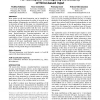Free Online Productivity Tools
i2Speak
i2Symbol
i2OCR
iTex2Img
iWeb2Print
iWeb2Shot
i2Type
iPdf2Split
iPdf2Merge
i2Bopomofo
i2Arabic
i2Style
i2Image
i2PDF
iLatex2Rtf
Sci2ools
CHI
2009
ACM
2009
ACM
Tilt techniques: investigating the dexterity of wrist-based input
Most studies on tilt based interaction can be classified as point-designs that demonstrate the utility of wrist-tilt as an input medium; tilt parameters are tailored to suit the specific interaction at hand. In this paper, we systematically analyze the design space of wrist-based interactions and focus on the level of control possible with the wrist. In a first study, we investigate the various factors that can influence tilt control, separately along the three axes of wrist movement: flexion/extension, pronation/supination, and ulnar/radial deviation. Results show that users can control comfortably at least 16 levels on the pronation/supination axis and that using a quadratic mapping function for discretization of tilt space significantly improves user performance across all tilt axes. We discuss the findings of our results in the context of several interaction techniques and identify several general design recommendations. Author Keywords Tilt-based interaction, wrist dexterity, rem...
CHI 2009 | Human Computer Interaction | Local Tilt Control | Tilt Based Interaction | Tilt Discretization Functions |
| Added | 24 Nov 2009 |
| Updated | 24 Nov 2009 |
| Type | Conference |
| Year | 2009 |
| Where | CHI |
| Authors | Mahfuz Rahman, Sean Gustafson, Pourang Irani, Sriram Subramanian |
Comments (0)

